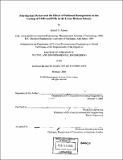Polyethylene devices and the effects of sediment resuspension on the cycling of PAHs and PCBs in the lower Hudson Estuary
Author(s)
Adams, Rachel G. (Rachel Gwen), 1972-
DownloadFull printable version (12.86Mb)
Other Contributors
Massachusetts Institute of Technology. Dept. of Civil and Environmental Engineering.
Advisor
Philip M. Gschwend.
Terms of use
Metadata
Show full item recordAbstract
In order to examine the importance of sediment resuspension on the sediment bed-to-water column transport of hydrophobic organic contaminants (HOCs) in the lower Hudson Estuary, the following areas of research were pursued: 1) a passive, in situ sampler, a polyethylene device (PED), for measuring HOCs in the aquatic environment was developed; 2) the desorption rate of pyrene, a polycyclic aromatic hydrocarbon (PAH), from native Hudson River sediments was measured, and 3) pyrene and 2,2',5,5'-tetrachlorobiphenyl (PCB #52), a polychlorinated biphenyl (PCB), concentrations were measured in the lower Hudson Estuary so that the input of these chemicals as a result of sediment resuspension could be compared to modeling expectations and the contribution of sediment resuspension to these chemicals' cycling could be quantified. The use of a new passive, in situ sampler, a polyethylene device (PED), for measuring hydrophobic organic contaminants (HOCs) in the aquatic environment was demonstrated. Like semipermeable membrane devices (SPMDs) and solid-phase microextraction (SPME), PEDs passively measure the concentration of chemical present in the dissolved phase. PEDs provide for in situ, time-averaged measurements with fast equilibration times (on the order of days) and simple laboratory extraction. Polyethylene-water equilibrium partitioning constants (KpEws) and polyethylene diffusivity coefficients (DPEs) were measured in the laboratory so that dissolved concentrations could be calculated subsequent to PED extraction. (cont.) KPEWs for eleven PAHs and PCBs were found to correlate closely with octanol-water equilibrium partitioning constants (Kows; log KPEW = 1.1 log Kow-0.45, R2 = 0.85). Temperature and salinity dependence of KPEW for the chemical of interest can be predicted with that chemical's excess enthalpy of solution and Setschenow constant, respectively. DpEs for several HOCs were measured in the laboratory so that the time for equilibrium uptake in the field could be predicted. PEDs allowed for quick, in situ, time-averaged measurements of phenanthrene and pyrene at pM concentrations and PCB #52 at fM concentrations in Boston Harbor seawater. Observations of disequilibrium between sorbed HOCs (e.g., PAHs & PCBs) and the surrounding environmental waters indicate that the times for desorption are important for understanding the fate of HOCs. Settling and resuspended particles can play a significant role in the cycling of HOCs. For PAHs, like pyrene, these chemicals' strong affinity for black carbon in the environment makes the rate of desorption less certain. The desorption rate for pyrene from native Hudson River sediment was measured in the laboratory and a diffusion rate constant (effective diffusivity/particle radius2) ranging from 1.OE-7 to 5.6E-7 s-1 was measured. The results were in good agreement with a physically- and chemically-based model for estimating effective diffusivity and the rate of desorption.
Description
Thesis (Ph. D .)--Massachusetts Institute of Technology, Dept. of Civil and Environmental Engineering, 2003. Includes bibliographical references (p. 149-154).
Date issued
2003Department
Massachusetts Institute of Technology. Department of Civil and Environmental EngineeringPublisher
Massachusetts Institute of Technology
Keywords
Civil and Environmental Engineering.